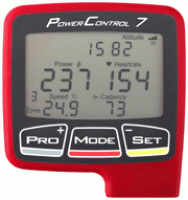SRM Power Meter Overview

SRM power measurement is transmitted to the Power Control 7 wirelessly from the strain gauges in the SRM Power Meter crankset. Other head units can be used also, such as the Garmin 500 or 800 models.
Direct measurement
The SRM approach directly measures actual power produced by the rider. Certain other brands measure power in the bottom bracket or rear wheel, an approach which inserts additional mechanical losses prior to measurement.
Arguably the SRM approach of measuring power at the cranks is superior, because it measures actual power produced by the rider as close as possible to the source of that power (the feet). Such distinctions are probably of little interest except to the professional cyclist; more important to my training is consistency, not absolute accuracy.
SRM claims accuracy of 2% for power measurements. In my view, this is not entirely ideal for rigorous training (intervals), since 200 watts vs 204 watts is a significant difference equating to 30:00 vs 30:36. But perhaps a consistent pedal stroke reduces the error— SRM does not explain further.
Power transmitted to the rear wheels will be slightly less than as measured at the cranks (from mechanical losses), but given the stiffness of the cranks and the Trek Madone 6.9 SSL and the Lightweight Ventoux wheels of my bike, this loss is likely very small, and it feels that way on my bike.
Head Unit
If you’re getting SRM, get the Power Control 7 with it, but admittedly this is a personal preference (see my review and bugs page); some users are quite happy with a unit like the Garmin Edge 500.
Models
SRM offers many different models. On the following pages the Shimano DuraAce 7900 and 7950 are discussed. Both are in personal use on my two Trek Madone 6.9 SSL road bikes.
Installation note for Trek Madone 6.9 SSL
A reader poses this question:
I have a Trek Madone 6.9ssl built in Di2 and now using a SRM crank (Shimano 7800 with 7900 rings). I was wondering if you have any tips on how to fix the cadence magnet under the BB? It doesn't seem to fit under the battery mount bracket. I couldn't see it on your pictures.
I did not install the magnet myself. From Neil at Palo Alto Bicycles, my trusted mechanic who installed the magnet and SRM crankset—
The cadence magnet for an SRM crank set will fit between the battery cradle and the Di2 specific Madone frame insert for the cradle mount. While the plastic part of the cadence magnet supplied from SRM is curved to match a normal BB shell, it will flatten out without issue. Just make sure that the magnet lines up with the dot found on the SRM spider. That dot indicates where the magnetic trip is for the crank computer to turn on. An alternative that is equally effective is to mount a magnet directly to the frame. Quarq, now owned by SRAM, uses this method with a simply two part epoxy putty to secure the magnet. It is a secure fastener that is ultimately removable it needed. Quarq/SRAM now make this magnet available after market and is currently available at your better LBS.




